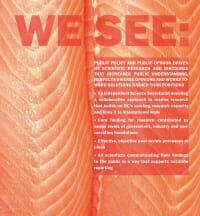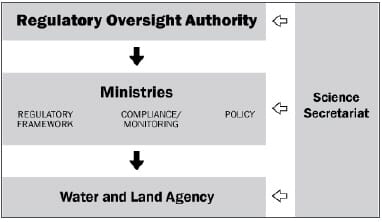The industrial and environmental conflicts that have hampered these waters - iconically illustrated by the collapse of wild salmon stocks - has been well documented by the international media. Whilst negative claims, drudged up from the muddy waters of scientific debate, have damaged the reputation of local aquaculture operations and garnered public mistrust.
Evidence of the true level of damage evoked a governmental response back in December of 2004, when six independent researchers were appointed under the leadership of honorable John Faser. This Forum set about unravelling the issue and formed a multifaceted solution involving the protection of the environment, the industry and the society as a whole.
The Forum’s direct investment of over $2.2 million in collaborative scientific research resulted in the addition of cash and in-kind support from governments, universities, foundations and industry leading to over $5.5 million in new research in British Columbia.
"This vision and the current reality of wild and farmed salmon management are separated by a considerable gap. Bridging this gap will require a transformation of attitudes and practices of government, business and the public, beginning with a significant change in management paradigms as well as a change in governance, improved science, better information and a higher level of public communications", said the Forum.
"Time is of the essence."
The Vision

extract from report
The Forum said that their solution begins at the watersheds, where wild salmon begin their lives. Here, Multiple human activities and climate change must be fully and transparently monitored with real -- independently reviewed -- indicators, before the available resources can be to balanced and managed in a sustainable manner.
The first recommendation of the Forum says that an ecosystem approach to managing all resources in water sheds and marine environments must be created. Strengthened ecological resilience will support wild salmon, says the report, but this requires that resource decisions must be taken out of the hands of multiple agencies and must be managed from a new single agency that can consider the capacity of the whole watershed to facilitate change.
As part of its plan the report indicates a need for the establishment of a "practical set of eco-system indicators" to be put in place by 2012. These indicators will provide a decisive set of standards on water temperature, integrity of riparian systems, water quality, stream flows and wildlife values required to support fish and their habitat. New and existing industries must cohere to these measures.
The Forum states that by 2009 these measures can be linked to carbon schemes which will, in turn, offset the cost of these initiatives through eligible claims to BC Carbon Trust funds. Further support can be gathered from the Canadian government in the form of habitat restoration programmes, whilst public support, First Nation involvement and conservative corporations will also be of value.
The aim is to have a new BC Land and Water Agency effective as of 2012. This will help managers understand what is required to keep the waters they occupy healthy, streamlining regulations across all levels of government and fairly separating overlapping interests. Measures are also being taken to ensure the economic future of local communities by diversifying available industries to cater for these changes, whilst allowing them to take part in the programme with an open supply of transparent information.
BC salmon farms will work with performance based indicators and must strictly adhere to a coordinated area management approach. The issue of sea lice in salmon and what level of effect sea lice have on wild stocks is a huge point of contention in British Columbia's watershed. Although there is no conclusive evidence on the subject, it is clear that the presence of sea lice creates problems for fish farmers.
* "The first step toward a better future is to define it" |
|
BC Pacific Salmon Forum
|
According to the Forum "interim research showed that no more than 3 per cent of juvenile wild pink and chum salmon of less than 0.5 grammes should have more than one pre-adult or later stage sea lice between March 1 and May 31."
The report states: "The coordinated area management plan together with a scientifically supportable monitoring program of sea lice on both farmed and wild fish must be continued for at least the next five years with an evaluation using the Finite Volume Coastal Ocean Model."
This model is a new tool developed as part of the Forum's work to bring clarity to the scientific debate regarding the impact of sea lice from fish farms on wild salmon and to gain a clearer picture of the complex dynamics of the Broughton ecosystem.
The Forum claims that this dynamic model can estimate sea lice egg production on farms. It can also track and provide projections of lice movements from farms into the environment and can compare these with lice populations measured on wild fish.
In conjunction with these measure the Forum also recommended regulations that will limit the annual production of salmon to 18,500 tonnes of farmed fish initially, (the average annual production between 1999 and 2007). These measures aim to ensure the protection of wild salmon runs.
Materialisation
The aim is that by adopting the proposed control measures and providing a variety of options for the treatment of parasites and disease, the use of chemical therapeutics will steadily decrease. Close monitoring of the situation combined with threshold targets will be documented with a transparent public review. Consequently, this will improve public confidence in wild and farmed salmon management, whilst enabling the different industries and organisations to collaborate in the creation of a new body for research and development, based on real unbiased science.
Ultimately, the project will reach its final stages by becoming a "centre of excellence for ecosystem based research on marine and watershed systems that support salmon." Core funding for a Science Secretariat will be provided through federal and provincial governments, whilst a third party certification body should be encouraged to oversee the developments independently.

In response to calls to replace the current farms with on land closed containment operations, the report recommends the implementation of a commercial scale trial. The success of such a project will rely on the ability to significantly reduce disease and parasites, whilst effectively disposing of waste.
"Other research topics could include research on the effects of sea lice on juvenile coho, chinook and sockeye salmon, the development of risk assessment models, research on how salmon survival is impacted by changing conditions in the Pacific Ocean, and the evaluation of environmental impacts from industrial activity such as use of nighttime lights on salmon farms", says the report.
"If British Columbia is to move toward sustainable salmon populations, we hope that this report, and the work of the Forum over the past four years, will be treated as only ‘the end of the beginning’. There are hard choices ahead and much work to be done.
"The first step toward a better future is to define it", says the Forum. "Whether this definition is called a goal or a vision is not important; what is important is that the future be described clearly so that we can measure society’s progress toward it."
Further Reading
| - | You can view the full report by clicking here. |
February 2009




